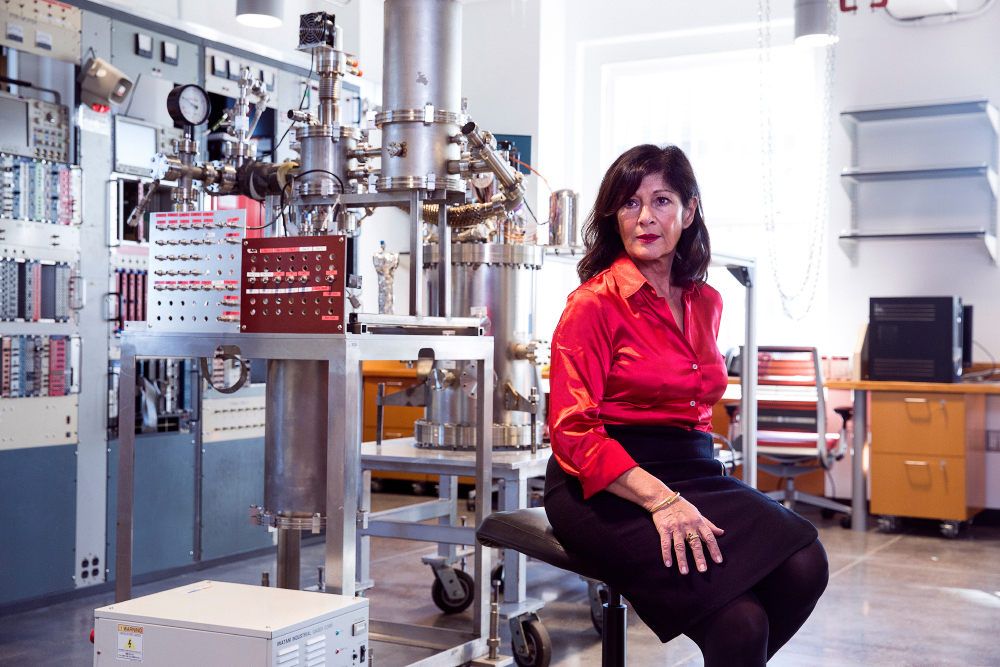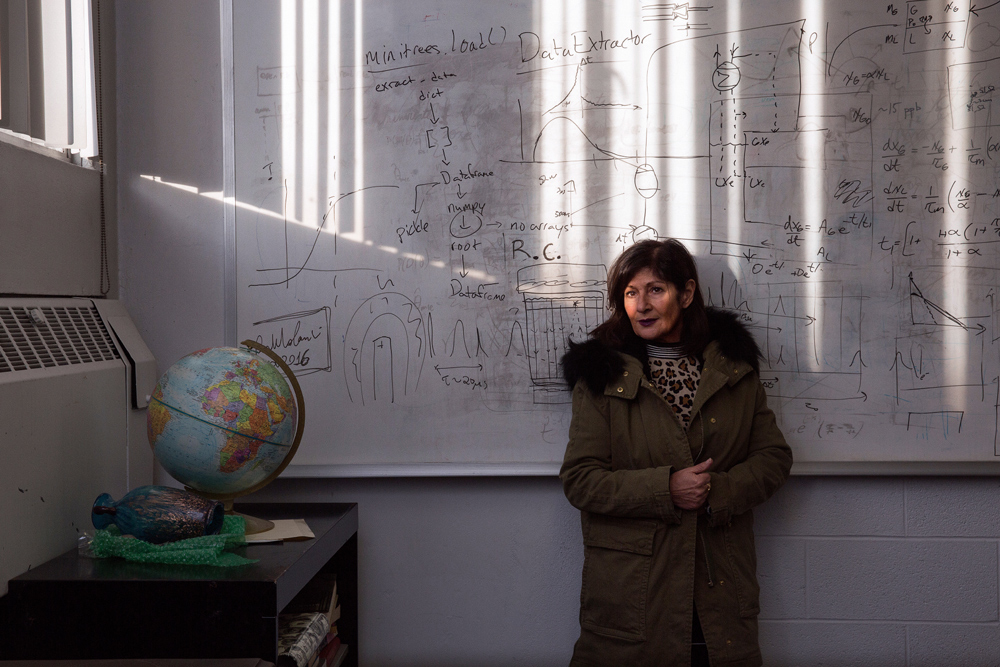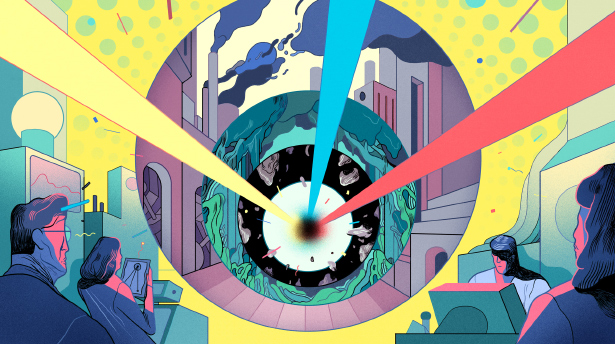In the Deep, a Drive to Find Dark Matter

In a lab buried under the Apennine Mountains of Italy, Elena Aprile, a professor of physics at Columbia University, is racing to unearth what would be one of the biggest discoveries in physics.
She has not yet succeeded, even after more than a decade of work. Then again, nobody else has, either.
Aprile leads the XENON dark matter experiment, one of several competing efforts to detect a particle responsible for the astrophysical peculiarities that are collectively attributed to dark matter. These include stars that rotate around the cores of galaxies as if pulled by invisible mass, excessive warping of space around large galaxy clusters, and the leopard-print pattern of hot and cold spots in the early universe.
For decades, the most popular explanation for such phenomena was that dark matter is made of as-yet undiscovered weakly interacting massive particles, known as WIMPs. These WIMPs would only rarely leave an imprint on the more familiar everyday matter.
That paradigm has recently been under fire. The Large Hadron Collider located at the CERN laboratory near Geneva has not yet found anything to support the existence of WIMPs. Other particles, less studied, could also do the trick. Dark matter’s astrophysical effects might even be caused by modifications of gravity, with no need for the missing stuff at all.
The most stringent WIMP searches have been done using Aprile’s strategy: Pour plenty of liquid xenon — a noble element like helium or neon, but heavier — into a vat. Shield it from cosmic rays, which would inundate the detector with spurious signals. Then wait for a passing WIMP to bang into a xenon atom’s nucleus. Once it does, capture out the tiny flash of light that should result.
These experiments use progressively larger tanks of liquid xenon that the researchers believe should be able to catch the occasional passing WIMP. Each successive search without a discovery shows that WIMPs, if they exist, must be lighter or less prone to leave a mark on normal matter than had been assumed.
In recent years, Aprile’s team has vied with two close competitors for the title of Most-thorough WIMP Search: LUX, the Large Underground Xenon experiment, a U.S.-based group that split from her team in 2007, and PandaX, the Particle and Astrophysical Xenon experiment, a Chinese group that broke away in 2009. Both collaborators-turned-rivals also use liquid-xenon detectors and similar technology. Soon, though, Aprile expects her team to be firmly on top: The third-generation XENON experiment — larger than before, with three and a half metric tons of xenon to catch passing WIMPs — has been running since the spring, and is now taking data. A final upgrade is planned for the early 2020s.
The game can’t go on forever, though. The scientists will eventually hit astrophysical bedrock: The experiments will become sensitive enough to pick up neutrinos from space, flooding the particle detectors with noise. If WIMPs haven’t been detected by that point, Aprile plans to stop and rethink where else to look.
Aprile splits her time between her native Italy and New York City. Quanta caught up with her on a Saturday morning in her Brooklyn high-rise apartment that faces toward the Statue of Liberty. An edited and condensed version of the interview follows.
QUANTA MAGAZINE: How closely do you follow the theoretical back and forth about the nature of dark matter?
ELENA APRILE: For me, driving the technology, driving the detector, making it the best detector is what makes it exciting. The point right now is that in a couple of years, maybe four or five in total, we will definitely say there is no WIMP or we will discover something.
I don’t care much about what the theorists say. I go on with my experiment. The idea of the WIMP is clearly today still quite ideal. Nobody could tell you “No, you’re crazy looking for a WIMP.”

What do you imagine will happen over the next few years in this search?
If we find a signal, we have to go even faster and build a larger scale detector which we are planning already — in order to have a chance to see more of them, and have a chance to build up the statistics. If we see nothing after a year or two, the same story.
The plan for the collaboration, for me and how I drive these 130 people, is very clear for the next four or five years. But beyond that, we will go almost to the level that we start really to see neutrinos. If we end up being lucky — if a supernova goes off next to us and we see neutrinos — we will not have found dark matter, but still detect something very exciting.
How did you get started with this xenon detector technology?
I started my career as a summer student at CERN. Carlo Rubbia was a professor at Harvard and also a physicist at CERN. He proposed a liquid-argon TPC — time projection chamber. This was hugely exciting as a detector because you can measure precisely the energy of a particle, and you can measure the location of the interaction, and you can do tracking. So, that was my first experience, to build the first liquid-argon ‘baby’ detector — 1977, yes, that’s when it started. And then I went to Harvard, and I did my early work with Rubbia on liquid argon. That was the seed that led eventually to the monstrous, huge liquid-argon detector called ICARUS.
Later, I left Rubbia and I accepted the position of assistant professor here at Columbia. I got interested in continuing with liquid-argon detectors, but for neutrino detection from submarines. I got my first grant from DARPA [the Defense Advanced Research Projects Agency]. They didn’t give a damn about supernova neutrinos, but they wanted to see neutrinos from the [nuclear] Russian submarines. And then we had Supernova 1987A, and I made a proposal to fly a liquid-argon telescope on a high-altitude balloon to detect the gamma rays from this supernova.
I studied a lot — the properties of argon, krypton, xenon — and then it became clear that xenon is a much more promising material for gamma-ray detection. So I turned my attention to liquid xenon for gamma-ray astrophysics.
How did that swerve into a search for dark matter?
I had this idea that this detector I built for gamma-ray astrophysics could have been, in another version, ideal to look for dark matter. I said to myself: “Maybe it’s worth going into this field. The question is hot, and maybe we have the right tool to finally make some progress.”
It’s atypical that the NSF [National Science Foundation], for someone new like me, will fund the proposal right away. It was the strength of what I had done all those years with the a liquid-xenon TPC for gamma-ray astrophysics. They realized that this woman can do it. Not because I’m very bold and I proposed a very aggressive program — which of course is typical of me — but I think it was the work that we did for another purpose which gave the strength to the XENON program, which I proposed in 2001 to the NSF.
Ben Sklar for Quanta Magazine
Video: Elena Aprile explains how she hunts for dark matter in the world’s largest underground laboratory.
What was it like to go from launching high-altitude balloons to working underground?
We had quite a few balloon campaigns. It’s something that I would do again, and I didn’t appreciate it then. You get your detector ready, you sit it on this gondola. At some point you are ready, but you can’t do anything because every morning you go and you wait for the weather guy to tell you if it’s the right moment to fly. In that scenario you are a slave to something bigger than you, which you can’t do anything about. You go on the launch pad, you look at the guy measuring, checking everything, and he says “No.”
Underground, I guess, there is no such major thing holding you from operating your detector. But there are still, in the back of your mind, thoughts about the seismic resilience of what you designed and what you built.
In a 2011 interview with The New York Times about women at the top of their scientific fields, you described the life of a scientist as tough, competitive and constantly exposed. You suggested that if one of your daughters aspired to be a scientist you would want her to be made of titanium. What did you mean by that?
Maybe I shouldn’t demand this of every woman in science or physics. It’s true that it might not be fair to ask that everyone is made of titanium. But we must face it — in building or running this new experiment — there is going to be a lot of pressure sometimes. It’s on every student, every postdoc, every one of us: Try to go fast and get the results, and work day and night if you want to get there. You can go on medical leave or disability, but the WIMP is not waiting for you. Somebody else is going to get it, right? This is what I mean when I say you have to be strong.
Going after something like this, it’s not a 9-to-5 job. I wouldn’t discourage anyone at the beginning to try. But then once you start, you cannot just pretend that this is just a normal job. This is not a normal job. It’s not a job. It’s a quest.
In another interview, with the Italian newspaper La Repubblica, you discussed having a brilliant but demanding mentor in Carlo Rubbia, who won the Nobel Prize for Physics in 1984. What was that relationship like?
It made me of titanium, probably. You have to imagine this 23-year-old young woman from Italy ending up at CERN as a summer student in the group of this guy. Even today, I would still be scared if I were that person. Carlo exudes confidence. I was just intimidated.
He would keep pushing you beyond the state that is even possible: “It’s all about the science; it’s all about the goal. How the hell you get there I don’t care: If you’re not sleeping, if you’re not eating, if you don’t have time to sleep with your husband for a month, who cares? You have a baby to feed? Find some way.” Since I survived that period I knew that I was made a bit of titanium, let’s put it that way. I did learn to contain my tears. This is a person you don’t want to show weakness to.
Now, 30 years after going off to start your own lab, how does the experience of having worked with him inform the scientist you are today, the leader of XENON?
For a long time, he was still involved in his liquid-argon effort. He would still tell me, “What are you doing with xenon; you have to turn to argon.” It has taken me many years to get over this Rubbia fear, for many reasons, probably — even if I don’t admit it. But now I feel very strong. I can face him and say: “Hey, your liquid-argon detector isn’t working. Mine is working.”
I decided I want to be a more practical person. Most guys are naive. All these guys are naive. A lot of things he did and does are exceptional, yes, but building a successful experiment is not something you do alone. This is a team effort and you must be able to work well with your team. Alone, I wouldn’t get anywhere. Everybody counts. It doesn’t matter that we build a beautiful machine: I don’t believe in machines. We are going to get this damn thing out of it. We’re going to get the most out of the thing that we built with our brains, with the brains of our students and postdocs who really look at this data. We want to respect each one of them.
Correction: On December 20, 2016, this article was changed to reflect that Aprile was not the first female professor of physics at Columbia University. The first female professor of physics at Columbia was C.S. Wu.
This article was reprinted on Wired.com.



